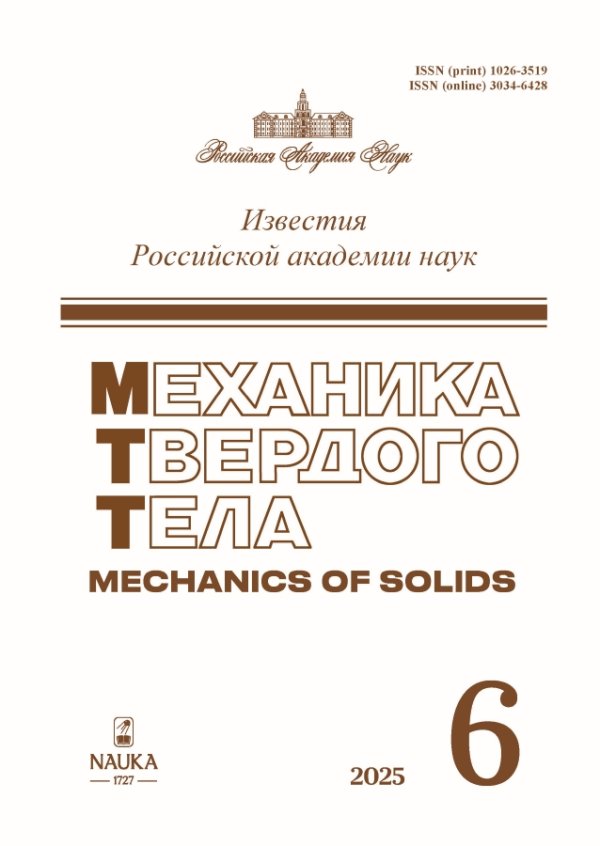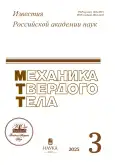HEAT-RESISTANT COATINGS BASED ON SILICON CARBIDE ON GRAPHITE
- Authors: Antipov V.V1, Galkin S.S2, Grashchenko A.S3, Klimov D.M2, Kolesnikov A.F2, Kukushkin S.A3, Osipov A.V3, Red'kov A.V3, Tepteeva E.S2, Chaplygin A.V2
-
Affiliations:
- Saint Petersburg State Technological Institute (Technical University)
- Institute for Problems in Mechanics named after A. Yu Ishlinsky RAS
- Institute of Problems of Mechanical Engineering RAS
- Issue: No 3 (2025)
- Pages: 270-288
- Section: Articles
- URL: https://journal-vniispk.ru/1026-3519/article/view/304233
- DOI: https://doi.org/10.31857/S1026351925030148
- EDN: https://elibrary.ru/bbkrlw
- ID: 304233
Cite item
Abstract
A method for forming heat-resistant silicon carbide coatings on graphite products is proposed and investigated. The coating is formed by simultaneous occurrence of several chemical reactions between the silicon melt, carbon monoxide and the near-surface region of graphite at temperatures slightly exceeding the melting point of silicon. The formed coating has a thickness of up to several millimeters, has high mechanical strength and hardness. The samples were examined by various methods, including Raman spectroscopy, SEM. Thermal resistance of the obtained coatings was studied by testing in high-enthalpy subsonic air flows. It was shown that the coatings withstand such exposure at temperatures up to 1750°C for 30 min. Mechanisms of self-healing of the coating under the influence of oxygen at high temperature were revealed.
About the authors
V. V Antipov
Saint Petersburg State Technological Institute (Technical University)
Email: sergey.a.kukushkin@gmail.com
S. S Galkin
Institute for Problems in Mechanics named after A. Yu Ishlinsky RAS
Email: sergey.a.kukushkin@gmail.com
A. S Grashchenko
Institute of Problems of Mechanical Engineering RAS
Email: sergey.a.kukushkin@gmail.com
D. M Klimov
Institute for Problems in Mechanics named after A. Yu Ishlinsky RAS
Email: sergey.a.kukushkin@gmail.com
A. F Kolesnikov
Institute for Problems in Mechanics named after A. Yu Ishlinsky RAS
Email: sergey.a.kukushkin@gmail.com
S. A Kukushkin
Institute of Problems of Mechanical Engineering RAS
Email: sergey.a.kukushkin@gmail.com
A. V Osipov
Institute of Problems of Mechanical Engineering RAS
Email: sergey.a.kukushkin@gmail.com
A. V Red'kov
Institute of Problems of Mechanical Engineering RAS
Email: sergey.a.kukushkin@gmail.com
E. S Tepteeva
Institute for Problems in Mechanics named after A. Yu Ishlinsky RAS
Email: sergey.a.kukushkin@gmail.com
A. V Chaplygin
Institute for Problems in Mechanics named after A. Yu Ishlinsky RAS
Author for correspondence.
Email: sergey.a.kukushkin@gmail.com
References
- Li J., Dunzik-Gouga M. L., Wang J. Recent advances in the treatment of irradiated graphite: A review // Ann. Nucl. Energy. 2017. V. 110. P. 140–147. https://doi.org/10.1016/j.anucene.2017.06.040
- Chung D.D.L. Review graphite // J. Mater. Sci. 2002. V. 37. P. 1475–1489. https://doi.org/10.1023/A:1014915307738
- Fallahdoost H., Nouri A., Azimi A. Dual functions of TiC nanoparticles on tribological performance of Al/graphite composites // J. Phys. Chem. Solids. 2016. V. 93. P. 137–144. https://doi.org/10.1016/j.jpcs.2016.02.020
- Py X., Olives R., Mauran S. Paraffin/porous-graphite-matrix composite as a high and constant power thermal storage material // Int. J. Heat Mass Transfer. 2001. V. 44. № 14. P. 2727–2737. https://doi.org/10.1016/S0017-9310(00)00309-4
- Rozenberg A.S., Sinenko Y.A., Chukanov N.V. Regularities of pyrolytic boron nitride coating formation on a graphite matrix // J. Mater. Sci. 1993. V. 28. P. 5528–5533. https://doi.org/10.1007/BF00367825
- Chen Z.B., Bian H., Hu S.P., Song X.G., Niu C.N., Duan X.K. et al. Surface modification on wetting and vacuum brazing behavior of graphite using AgCu filler metal // Surf. Coat. Technol. 2018. V. 348. P. 104–110. https://doi.org/10.1016/j.surfcoat.2018.05.039
- Cho Y.J., Summerfield A., Davies A., Cheng T.S., Smith E.F., Mellor C.J. et al. Hexagonal boron nitride tunnel barriers grown on graphite by high temperature molecular beam epitaxy // Sci. Rep. 2016. V. 6. P. 34474. https://doi.org/10.1038/srep34474
- Fu Q.G., Li H.J., Shi X.H., Li K.Z., Sun G.D. Silicon carbide coating to protect carbon/carbon composites against oxidation // Scr. Mater. 2005. V. 52. № 9. P. 923–927. https://doi.org/10.1016/j.scriptamat.2004.12.029
- Wang R.Q., Zhu S.Z., Huang H.B., Wang Z.F., Liu Y.B., Ma Z., Qian F. Low-pressure plasma spraying of ZrB2-SiC coatings on C/C substrate by adding TaSi2 // Surf. Coat. Technol. 2021. V. 420. P. 127332. https://doi.org/10.1016/j.surfcoat.2021.127332
- Liu X.F., Huang Q.Z., Su Z.A., Jiang J.X. Preparation of SiC coating by chemical vapor reaction // J. Chin. Ceram. Soc. 2004. V. 32. № 7. P. 906–910.
- Kang P., Zhang B., Chen G., Wu G. Synthesis of nanostructured SiC coatings on carbon fibres by in situ reaction sintering with milled powders // Surf. Coat. Technol. 2010. V. 205. № 2. P. 294–298. https://doi.org/10.1016/j.surfcoat.2010.06.043
- Okuni T., Miyamoto Y., Abe H., Naito M. Joining of silicon carbide and graphite by spark plasma sintering // Ceram. Int. 2014. V. 40. № 1. P. 1359–1363. https://doi.org/10.1016/j.ceramint.2013.07.017
- Lee J.E., Kim B.G., Yoon J.Y., Ha M.T., Lee M.H., Kim Y. et al.The role of an SiC interlayer at a graphite–silicon liquid interface in the solution growth of SiC crystals // Ceram. Int. 2016. V. 42. № 10. P. 11611–11618. https://doi.org/10.1016/j.ceramint.2016.04.060
- Zhu Q., Qiu X., Ma C. Oxidation resistant SiC coating for graphite materials // Carbon. 1999. V. 37. № 9. P. 1475–1484. https://doi.org/10.1016/S0008-6223(99)00010-X
- Li Y., Wang Q., Fan H., Sang S., Li Y., Zhao L. Synthesis of silicon carbide whiskers using reactive graphite as template // Ceram. Int. 2014. V. 40. № 1. P. 1481–1488. https://doi.org/10.1016/j.ceramint.2013.07.032
- Hu L., Zou Y., Li C.H., Liu J.A., Shi Y.S. Preparation of SiC nanowires on graphite paper with silicon powder // Mater. Lett. 2020. V. 269. P. 127444. https://doi.org/10.1016/j.matlet.2020.127444
- Al-Ruqeishi M. S., Nor R. M., Amin Y. M., Al-Azri K. Direct synthesis of β-silicon carbide nanowires from graphite only without a catalyst // J. Alloys Compd. 2010. V. 497. № 1–2. P. 272–277. https://doi.org/10.1016/j.jallcom.2010.03.025
- Haibo O., Hejun L., Lehua Q., Zhengjia L., Jian W., Jianfeng W. Synthesis of a silicon carbide coating on carbon fibers by deposition of a layer of pyrolytic carbon and reacting it with silicon monoxide // Carbon. 2008. V. 46. № 10. P. 1339–1344. https://doi.org/10.1016/j.carbon.2008.05.017
- Grashchenko A.S., Kukushkin S.A., Osipov A.V., Redkov A.V. Formation of composite SiC-C coatings on graphite via annealing Si-melt in CO // Surf. Coat. Technol. 2021. V. 423. P. 127610. https://doi.org/10.1016/j.surfcoat.2021.127610
- Grashchenko A.S., Kukushkin S.A., Osipov A.V., Redkov A.V. Mechanical properties of a SiC composite coating on graphite obtained by the atomic substitution method // Letters to the Journal of Technical Physics. 2021. V. 47. No. 20. P. 7–10. https://doi.org/10.21883/PJTF.2021.20.51605.18918 [in Russian].
- Kukushkin S.A., Osipov A.V., Feoktistov N.A. Synthesis of epitaxial silicon carbide films through the substitution of atoms in the silicon crystal lattice: A review // Phys. Solid State. 2014. V. 56. P. 1507–1535. https://doi.org/10.1134/S1063783414080137
- Kukushkin S.A., Osipov A.V. A new method for the synthesis of epitaxial layers of silicon carbide on silicon owing to formation of dilatation dipoles // J. Appl. Phys. 2013. V. 113. № 2. P. 024909. https://doi.org/10.1063/1.4773343
- Kukushkin S.A., Osipov A.V. Theory and practice of SiC growth on Si and its applications to wide-gap semiconductor films // J. Phys. D: Appl. Phys. 2014. V. 47. № 31. P. 313001. https://doi.org/10.1088/0022-3727/47/31/313001
- Kukushkin S.A., Osipov A.V. New method for growing silicon carbide on silicon by solid-phase epitaxy: Model and experiment // Phys. Solid State. 2008. V. 50. P. 1238. https://doi.org/10.1134/S1063783408070081
- Gordeev A.N., Kolesnikov A.F. New modes of plasma flow and heat transfer in the high-frequency induction plasma torch VGU-4 // Physicochemical kinetics in gas dynamics. 2008. № 7. P. 18–18. [in Russian].
- Sevastyanov V.G., Simonenko E.P., Gordeev A.N., Simonenko N.P., Kolesnikov A.F., Papynov E.K. et al. Behavior of ceramic material HfB2-SiC (45 vol.%) in a flow of dissociated air and analysis of the emission spectrum of the boundary layer above its surface // Russ. Journal of Inorganic Chemistry. 2015. V. 60. No. 11. P. 1485–1485. https://doi.org/10.7868/S0044457X15110136 [in Russian].
- Simonenko E.P., Simonenko N.P., Kolesnikov A.F., Chaplygin A.V., Lysenkov A.S., Nagornov I.A. et al. Modification of UHTC composition HfB2–30% SiC with graphene (1 vol. %) and its effect on behavior in supersonic air flow // Russian Journal of Inorganic Chemistry. 2021. V. 66. № 9. P. 1314–1325. https://doi.org/10.31857/S0044457X21090142 [in Russian].
- Simonenko E.P., Simonenko N.P., Kolesnikov A.F., Chaplygin A.V., Papynov E.K., Shichalin O.O. et al. Effect of supersonic nitrogen flow on ceramic material Ta4HfC5–SiC // Journal of Inorganic Chemistry. 2023. V. 68. No. 4. P. 551–559. https://doi.org/10.31857/S0044457X22602358 [in Russian].
- Tuinstra F., Koenig J.L. Raman spectrum of graphite // J. Chem. Phys. 1970. V. 53. № 3. P. 1126–1130. https://doi.org/10.1063/1.1674108
- Nakashima S., Harima H. Raman investigation of SiCpolytypes // Phys. Status Solidi A. 1997. V. 162. № 1. P. 39–64. https://doi.org/10.1002/1521-396X(199707)162:1<39::AID-PSSA39>3.0.CO;2-L
- Kitaev Yu.E., Kukushkin S.A., Osipov A.V., Redkov A.V. New trigonal (rhombohedral) phase of SiC: abinitio calculations, symmetry analysis and Raman spectra // FTT. 2018. Issue 10. P. 2030–2035. https://doi.org/10.21883/FTT.2018.10.46534.107 [in Russian].
- Perova T.S., Kukushkin S.A., Osipov A.V. Raman microscopy and imaging of semiconductor films grown on SiChybrid substrate fabricated by the method of coordinated substitution of atoms on silicon // Handbook of silicon carbide materials and devices / Ed. Z.C. Feng. Boca Raton: CRC Press, 2022. P. 327–372. https://doi.org/10.1201/9780429198540
- Bates J.B. Raman spectra of α and βcristobalite // J. Chem. Phys. 1972. V. 57. № 9. P. 4042–4047. https://doi.org/10.1063/1.1678878
- Redkov A.V., Grashchenko A.S., Kukushkin S.A., Osipov A.V., Kotlyar K.P., Likhachev A.I. et al. Studying evolution of the ensemble of micropores in a SiC/Si structure during its growth by the method of atom substitution // Phys. Solid State. 2019. V. 61. P. 299–306. https://doi.org/10.1134/S1063783419030272
- Anisimov K.S., Malkov A.A., Malygin A.A. Mechanism of thermal oxidation of silicon carbide modified by chromium oxide structures // Russ. J. Gen. Chem. 2014. V. 84. P. 2375–2381. https://doi.org/10.1134/S1070363214120032
- Gorsky V.V., Gordeev A.N., Dudkina T.I. Aerothermochemical destruction of silicon carbide washed by a high-temperature air flow // TVT. 2012. V. 50. Issue 5. P. 692–699. [in Russian].
Supplementary files










